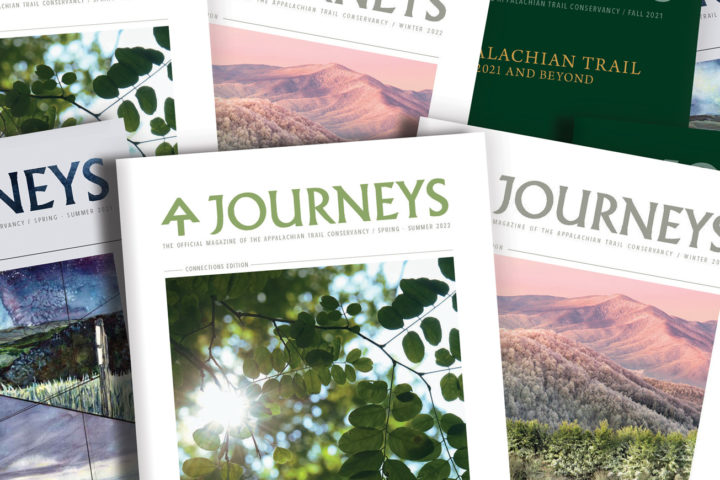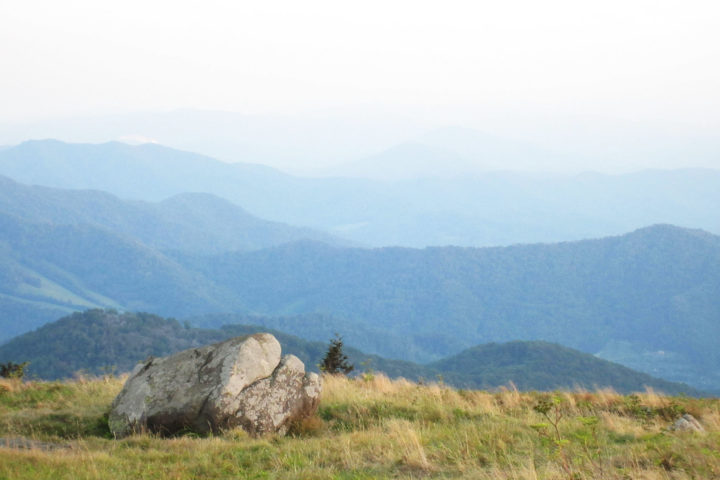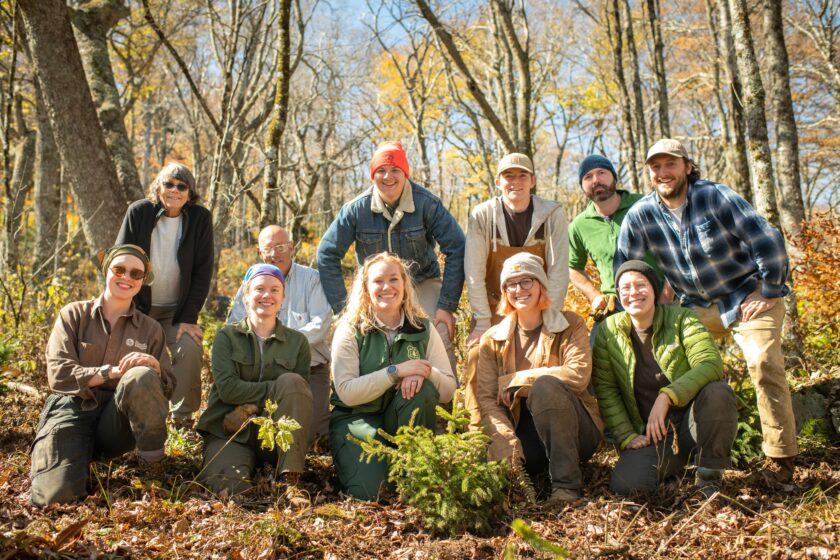By Kim O'Connell
Saving Islands in the Sky
April 28, 2023
On a golden October day, a dozen or so people headed off trail through an Appalachian forest. They climbed higher and higher, their boots crunching the leaf litter beneath them. Trees soared above their heads, many of them hardwoods, with leaves flashing amber and red.
Each person in the group had a different degree of familiarity with this section of woods, and a different amount of conservation experience. But they were united by what they carried in their hands — red spruce seedlings, none more than two feet tall — and their mission: to help restore the red spruce forest in the southern Appalachian Mountains.
A relic species of the last Ice Age that thrives in colder temperatures, the red spruce was once a mainstay of the eastern North American forest from the southern Appalachians to coastal Canada. However, in the 19th and early 20th centuries widespread logging cut its historic range in half. This made the remaining forests vulnerable to wildfires that burned with such intensity that they destroyed the very organic matter that spruce trees need for their seeds to sprout. In a warmer climate, red spruce in the southern Appalachians now exist mostly on the highest mountaintops, forming dark green “sky islands.” Further temperature increases will continue to stress the trees, making them more vulnerable to pests and wind disturbance events.
“Of that approximately 50 percent range that’s left, much of the forest is not in good shape,” says Matt Drury, associate director of science and stewardship, at the Appalachian Trail Conservancy (ATC). “Southern red spruce is globally imperiled, and many consider it one of the most endangered ecosystems in North America.”
Southern Appalachian forests are an ecological hotspot in the United States for species at risk of disappearing. Protecting biodiversity is essential to preserving human health and well-being, because healthy ecosystems ensure food and water supplies. Preserving the health of a single species, such as the red spruce, helps keep a complex ecosystem intact — benefiting human populations as well as plants and animals that rely on the spruce for their own survival.
An Unforgettable Experience
Walking on the Appalachian Trail (A.T.), when you enter a red spruce forest, you know it instantly, even if you can’t place the exact species. The air suddenly cools. Shadows cover the forest floor, shrouding the understory, the earth springy beneath your feet. Sunlight shafts between the brown corn-flaky trunks, bouncing off the yellow-green spruce needles, wherever it finds an opening. The air is filled with notes of pine and citrus.
Mature trees can grow between 60 to 130 feet tall, and some are as old as 350 years or more. But their hold on the landscape is tenuous. The trees are shade tolerant but only to a degree. When the tallest trees crowd the canopy, reducing light to the forest floor, smaller, younger spruce can suffer. For decades before the Clean Air Act, the species was susceptible to the effects of acid rain, and weak trees are also vulnerable to pests. Factor in other impacts of climate change and development — invasive species, more severe storms, habitat loss — and the red spruce is especially at risk.
“Sometimes spruce is its own worst enemy,” says Mark Ford, unit leader of the U.S. Geological Survey’s Virginia Cooperative Fish and Wildlife Research Unit, which is housed within the College of Natural Resources and Environment at Virginia Tech, and a frequent partner with ATC for forest restoration. “When it was exploited a hundred years ago, if the landscape didn’t burn, it would seed itself back in, but it would overdo it. It would seed itself in too densely. Trees are like everything else; they’ve got to have space and water and light. And so, throughout the southern and central Appalachians, there are stagnant, arrested stands of spruce trees that are anywhere from 40 to 80 years old that have just quit growing because there’s too much competition for resources.”
Building Resilience
The ATC’s spruce restoration work in the Southern Appalachians is part of a much larger conservation effort known as the Southern Appalachian Spruce Restoration Initiative (SASRI), which formally began in 2015. The effort involves federal and state agencies, academic institutions, other nonprofit organizations, private companies, and volunteers. The SASRI partnership has a collective goal of restoring red spruce ecosystems across the high elevations of the Southern Appalachians.
In late 2019, the ATC began working with SASRI partners like Ford at Virginia Tech, as well as researchers at Western Carolina University and Appalachian State University, to restore red spruce to parts of its historic range within the A.T. landscape. Together, they are focusing on places like Whitetop Mountain in Virginia and Roan and Unaka mountains in North Carolina and Tennessee — all well-known summits along the southern A.T.
According to Matt Drury, who recently completed his tenure as co-chair of SASRI and remains on the steering committee, the work ranges from canopy thinning and tree planting to monitoring, data collection, and other scientific research, with the goal of generating concrete information to inform management decisions down the line.
“We’re trying to build resilience in the system, structural diversity, with big trees, small trees, young trees, old trees,” Drury says, sounding unintentionally like the Lorax, and with equal gravity. “This way the spruce forest will be more resilient in the face of climate change and in the face of disturbance events including storms.”
The autumn tree planting took place on Whitetop Mountain, the second-highest peak in Virginia at 5,520 feet after nearby Mount Rogers (just 200 feet higher). Here, the A.T. is a province of open meadows and northern hardwood forests that give way to a fairyland of red spruce at its highest reaches. Songs of the winter wren, red crossbill, hermit thrush, and golden-crowned kinglet can be heard in these woods, rewarding patient birders. This part of southwest Virginia was heavily logged in the 1900s, and today much of the original spruce forests have been replaced with American beech, yellow birch, sugar maple, and other species.
The team chose six planting sites around Whitetop. The initial plan was to replace like with like, says Conner McBane, a natural resource specialist for the ATC based in Virginia. “Originally we collected hundreds of cones from Whitetop Mountain, thinking it would be desirable to plant this locally adapted ecotype,” he says. But after seeking advice from forest geneticists, the team instead sought out spruce specimens from the southern end of the tree’s range — places like the Great Smoky Moun-tains. Red spruce selected from more southerly latitudes are expected to have higher survival rates under current climate change projections on Whitetop Mountain.
“We planted southern red spruce on Whitetop to diversify stand genetics and improve climate change resiliency,” McBane says. “The majority of planting sites were designed for long-term habitat connectivity, but some were implemented to take advantage of canopy gaps caused by beech bark disease.”
The group planted seedlings at a range of ages from two years old to eight, sourced from the Southern Highlands Reserve, a key SASRI partner. Funding for the seedlings came from the U.S. Fish and Wildlife Service and private donors to the ATC, including the Jean Deeds Red Spruce Forest Restoration Fund. To date, the October spruce event represents one of the largest planting efforts.
This article is excerpted from the version published in the Spring 2023 edition of A.T. Journeys magazine. Become a member today to help fund great storytelling about the Appalachian Trail and the community of doers and dreamers that ensure the Trail is protected forever, for all.
Discover More

The ATC's Official Membership Magazine
A.T. Journeys
Our membership magazine provides an in-depth look at the work of the ATC to protect, manage, and advocate for the Appalachian Trail.

Learn More
About the ATC
We are the stewards of the world’s longest hiking-only footpath, the Appalachian Trail.

The A.T. Landscape Partnership
A Dynamic Approach to Landscape Conservation
The Appalachian Trail Landscape Partnership is a dedicated coalition of local, state and federal partners led by the Appalachian Trail Conservancy and the National Park Service.



